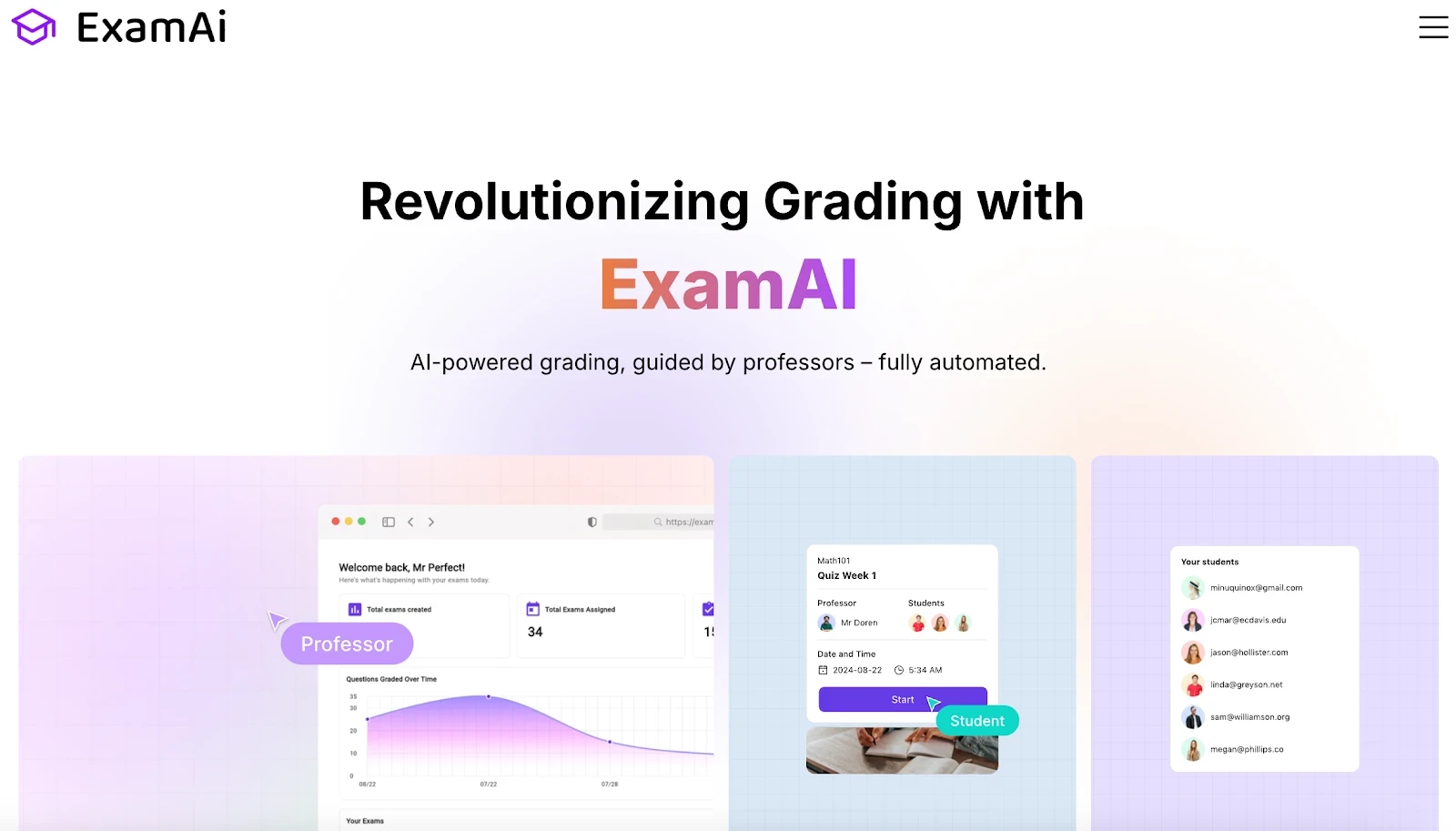Ever since the release of ChatGPT in 2022, AI has been constantly expanding its reach to multiple industries. One of which is the education sector.
AI is transforming the way students learn and teachers teach. With AI tools, classrooms are becoming more interactive, personalized, and efficient.
Let's talk about the role of AI in the classroom, how it's helping both teachers and students and more!
What is an AI Classroom?
An AI classroom is a learning environment where artificial intelligence supports teachers and students. Schools worldwide are starting to use AI tools to improve education, making lessons more interactive and data-driven.
Some of the most common features of an AI classroom include:
Smart tutoring systems - AI-powered tutors help students learn at their own pace.
Automated grading - AI can grade assignments and tests, saving teachers time.
Personalized learning paths - AI analyzes student performance and adjusts lessons based on strengths and weaknesses.
Virtual assistants and chatbots - These answer student questions, provide explanations, and guide learning.
Speech recognition and translation - AI helps students with disabilities and those who speak different languages.
Data-driven insights - AI tracks student progress and suggests improvements.
How AI is Used in Classrooms Today
Artificial intelligence is already making a difference in classrooms worldwide. Below are some of the most common ways AI is being used in classrooms today.
Personalized Learning for Every Student
Every student learns at their own speed. AI can adjust lessons, assignments, and quizzes to match their skills. This gives extra support to those who need it while letting advanced students move ahead.
Adapts lesson difficulty - AI analyzes student performance and adjusts lesson complexity.
Recommends study materials - AI suggests videos, readings, or exercises based on progress.
Provides instant feedback - Students get immediate corrections and tips for improvement.
Creates unique learning paths - AI helps students focus on topics they struggle with.
In 2024, EdTech Magazine shared that 25% of teachers saw AI helping with personalized learning, making it easier to adapt lessons to each student’s needs.
Automating Administrative Tasks
Teachers spend hours each week grading papers, tracking attendance, and preparing reports. AI can automate these tasks, giving teachers more time to focus on teaching.
Here's how AI can reduce teachers' workload:
Automated grading - AI can grade multiple-choice tests and even analyze essays.
Smart attendance tracking - AI-powered facial recognition or RFID systems can track attendance.
Data analysis for student progress - AI identifies trends and helps teachers support struggling students.
Report generation - AI creates detailed student performance reports.
Improving Engagement and Student Interaction
AI makes learning more interactive and exciting. Traditional lectures can be boring, but AI-powered tools keep students engaged through interactive lessons, virtual reality, and gamification.
Virtual Reality (VR) and Augmented Reality (AR) - AI-powered VR allows students to explore historical sites, conduct virtual science experiments, and engage in hands-on learning.
Gamified Learning - AI uses game-based lessons to make subjects like math and science fun.
AI-powered interactive quizzes - Students can participate in real-time quizzes with instant AI feedback.
Chatbots for instant help - AI chatbots answer student questions during lessons.
Reducing Costs for Schools and Students
AI lowers the cost of education by replacing expensive materials and manual processes with smart, digital alternatives.
Cuts down on paper and printing costs - Digital AI-powered textbooks and study materials replace physical copies.
Reduces the need for extra tutoring - AI tutors provide free or low-cost learning support.
Optimizes resource allocation - AI helps schools decide where to invest funding for the best student outcomes.
Automates administrative work - Schools save money by reducing the need for extra staff.
How Teachers Can Use AI Responsibly in the Classroom
In order to use AI responsibly, teachers should have what is called "AI literacy".
AI literacy is the ability to understand, use, and evaluate artificial intelligence responsibly. It means knowing what AI can and can't do, using it ethically, and recognizing when AI-generated content needs fact-checking.
Teachers need to understand AI’s strengths, limitations, and ethical concerns to use it responsibly in the classroom.
Here are some things to keep in mind if you use (or plan on using) AI tools in the classroom:
Balancing AI with Traditional Teaching Methods
AI shouldn’t replace traditional teaching. Instead, it should support teachers by making lessons more engaging and helping students learn better.
Let AI handle routine tasks – Use AI for grading, scheduling, and drafting lesson plans to save time.
Keep personal engagement a priority – Spend the saved time on direct student interactions, discussions, and feedback.
Stay in control – AI should assist, not dictate—teachers should always have the final say on content and grading.
Protect Data Privacy and Security
AI collects large amounts of student data, which can pose privacy risks if not managed properly. Teachers should only use AI tools that protect student information and follow data security guidelines.
Use AI tools with strong privacy policies - Choose platforms that comply with FERPA (Family Educational Rights and Privacy Act) and GDPR (General Data Protection Regulation).
Limit the data AI collects - Avoid AI systems that require excessive personal student information.
Educate students about data privacy - Teach students about digital footprints and online security.
Get parental consent - Before using AI tools that collect student data, inform parents and obtain approval if necessary.
Recognizing AI Bias
AI systems are only as good as the data they are trained on. If the data includes biases, stereotypes, or inaccuracies, the AI will reflect them. This can lead to unfair outcomes in grading, tutoring, or content recommendations.
Here are ways teachers can recognize bias:
Test AI-generated responses - Review AI recommendations for accuracy and fairness.
Teach students about AI bias - Help students recognize that AI is not always neutral or correct.
Report biased AI behavior - If an AI tool consistently produces biased responses, inform developers or switch tools.
Understanding AI’s Limitations
AI can generate useful insights, but it is not always accurate. AI models do not “think” like humans; they predict responses based on past data, which can lead to wrong or misleading information.
Here's how you can manage AI's limitations
Fact-check AI-generated content - AI can produce incorrect answers; always verify important information.
Monitor AI tutoring tools - AI-based tutoring should be used as support, not a replacement for teaching.
Encourage critical thinking - Teach students to question AI feedback and seek multiple sources.
Avoid full automation - AI should assist with tasks like grading and content recommendations, but final decisions should involve human oversight.
Be Transparent About AI Use
Teachers should openly communicate when AI is involved in grading, feedback, or other classroom tasks. This helps students understand how their work is evaluated and builds trust in the learning process.
Explain how AI grading works – Let students know if AI is used to check assignments, quizzes, or essays. Clarify that AI looks for patterns but doesn't replace human judgment.
Balance AI with teacher feedback – AI can provide quick results, but personal feedback from teachers is still important for meaningful learning.
Encourage questions about AI use – Give students a chance to ask about how AI-generated feedback is used and how they can improve their work.
Acknowledge AI’s limitations – Remind students that AI isn’t perfect and may sometimes misinterpret responses or miss important details.
See the Future of AI Classroom Grading with ExamAI
ExamAI makes grading faster, more accurate, and easier for professors. Students get instant feedback, making every exam a chance to learn. AI-powered grading and easy exam creation make assessments more efficient.
Save time on grading – AI quickly evaluates exams, reducing manual work.
Fair and consistent grading – AI removes bias for accurate results.
Easy integration – Export grades to Canvas, with Blackboard Learn coming soon.
Instant feedback – AI insights help students improve faster.
simplify the entire exam process with AI-powered accuracy. Try ExamAI today!
FAQs About AI Classroom
Can AI replace teachers?
AI tools can help in education, but they can’t replace teachers. Artificial intelligence can handle administrative tasks, create lesson plans, and track student progress, but it lacks the human connection needed for student learning.
Teachers guide students, encourage critical thinking, and create meaningful student interactions that AI platforms can't replicate. While AI technology can support students by providing extra resources and personalized learning experiences, it works best as a tool alongside teachers, not as a replacement.
How is AI used at school?
AI is already part of many classrooms, helping teachers and students in different ways. Generative AI assists with lesson plans, while AI algorithms in platforms like Google Classroom track student progress and suggest personalized learning activities.
AI tools also help automate administrative tasks, giving teachers more time to focus on student engagement. In higher education, AI technology is used for grading assignments, managing course materials, and even tutoring students. The goal is to support students, not take over the learning process.
Why are teachers against ChatGPT?
Some teachers worry that ChatGPT and other generative AI tools might affect academic integrity by making it easier for students to submit AI-generated work instead of doing their own. Others are concerned that relying too much on AI could weaken critical thinking skills.
While AI can be useful for brainstorming ideas and improving student learning, it should be used carefully. Many schools are figuring out how to balance new technology with traditional learning methods to ensure students benefit without losing essential skills.
Can AI make us smarter?
AI technology can help people learn faster and more effectively by providing instant feedback, personalized learning paths, and access to vast amounts of information. AI platforms improve student engagement by offering interactive learning experiences and adapting to individual needs.
However, becoming smarter isn't just about using AI tools—it requires critical thinking, curiosity, and effort. AI can support students in reaching their learning objectives, but real growth comes from applying knowledge in meaningful ways.



